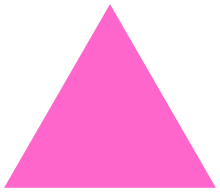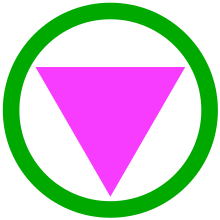Pink triangle

In Nazi Germany, pink triangles (German: Rosa Winkel)[2] were used as one of the Nazi concentration camp badges, used to identify male prisoners who were sent there because of their homosexuality.[3][4] Every prisoner had to wear a downward-pointing triangle on their jacket, the colour of which was to categorise them by "kind". Other colors identified Jewish people (two triangles superimposed as a yellow star), political prisoners, Jehovah's Witnesses, "anti-social" prisoners, and others the Nazis deemed undesirable. Pink and yellow triangles could be combined if a prisoner was deemed to be gay and Jewish.[5]
Originally intended as a badge of shame, the pink triangle (often inverted from its Nazi usage) has been reclaimed as an international symbol of gay pride and the gay rights movement, and is second in popularity only to the rainbow flag.[6]
History
Under Nazi Germany every prisoner had to wear a concentration camp badge on their jacket, the color of which categorized them into groups. Gay men had to wear the Pink Triangle. Other colors identified Jewish people (two triangles superimposed as a yellow star), political prisoners, Jehovah's Witnesses, "anti-social" prisoners, and others the Nazis deemed undesirable.
While the number of gay men in German concentration camps is hard to estimate, Richard Plant gives a rough estimate of the number of men convicted for homosexuality "between 1933 to 1944 at between 50,000 and 63,000."[4]
After the camps were liberated at the end of the Second World War, many of the pink triangle prisoners were often simply re-imprisoned by the Allied-established Federal Republic of Germany. An openly gay man named Heinz Dörmer, for instance, served 20 years total, first in a Nazi concentration camp and then in the jails of the new Republic. In fact, the Nazi amendments to Paragraph 175, which turned homosexuality from a minor offense into a felony, remained intact in both East and West Germany after the war for a further 24 years. While suits seeking monetary compensation have failed, in 2002 the German government issued an official apology to the gay community.[7]

| LGBT symbols |
|---|
By the end of the 1970s, the pink triangle was adopted as a symbol for gay rights protest.[8][9] Some academics have linked the reclamation of the symbol with the publication, in the early 1970s, of gay concentration camp survivor Heinz Heger's memoir, The Men with the Pink Triangle.[10] In the hit 1975 movie The Rocky Horror Picture Show, the pansexual, transvestite character Dr. Frank N. Furter wears the pink triangle on one of his (many) outfits.
Until 1985 there was an unofficial ban on placing pink triangle wreaths at the Cenotaph, and such wreaths were removed shortly after being placed.[11]
The AIDS Coalition To Unleash Power (ACT UP) adopted an inverted pink triangle along with the slogan "SILENCE = DEATH" as its logo shortly after its formation by six gay activists in New York City in 1987.[12][13]
In 1995, after a decade of campaigning, a pink triangle plaque was installed at the Dachau Memorial Museum to commemorate the suffering of gay men and lesbians.[14] In 2001 Robert Randolph Davis, rented a storefront boutique at 616 N Doheny Dr, West Hollywood CA, 90069 for the sole purpose of displaying his collection of 61 LGBT community armbands that he acquired years earlier from a Dr. who had gone to the concentration camps when they were being liberated. The doctor was given the armbands by a gay holocaust victim that wanted the Doctor to share them with the world. After the passing of the doctor 60 years later, his estate was auctioned off and the armbands were part of a sealed chest that was purchased by Davis. The Los Angeles times did an exclusive story of Davis's "Holiday Window of Compassion" word spread fast of this touching tribute to the LGBT community that suffered in the holocaust. The armbands were put on display in the window along with a poem Davis wrote to honor the pieces of LGBT history and to show the world and the community that they were there. People were flocking to this tribute in the thousands.The tribute remained on display till January 20, 2002
On August 3, 2011 Rudolf Brazda died at the age of 98; he was the last known homosexual deportation survivor.
In 2015 the pink triangle was included in the Legacy Walk.[15]
The pink triangle is the basis of the design of the Homomonument in Amsterdam, the Gay and Lesbian Holocaust Memorial in Sydney, the Pink Triangle Park in the Castro neighbourhood of San Francisco and the huge 1-acre (4,000 m2) Pink Triangle on Twin Peaks that is displayed every year during San Francisco Pride weekend in San Francisco.[16] It is also the basis of the design of the LGBT memorials in Barcelona, Sitges and Montevideo, and the burial component of the LGBT Pink Dolphin Monument in Galveston.
The Pink Panthers Movement is a militant activist group out of Denver, Colorado, USA. The PPM adopted a pink triangle with clawed panther print logo, adapted from the original Pink Panthers Patrol in New York City.
Examples
- Some examples of the pink triangle from Nazi camps used in memorials
- Pink triangle (Rosa Winkel in German) memorial for gay men killed at Buchenwald.
 In the Berlin Nollendorfplatz subway station, a pink triangle plaque honors gay male victims. (Photo by: Manfred Brueckels.)
In the Berlin Nollendorfplatz subway station, a pink triangle plaque honors gay male victims. (Photo by: Manfred Brueckels.) Amsterdam's Homomonument uses pink triangles symbolically to memorialize gay men killed in the Holocaust (and also victims of anti-gay violence generally).
Amsterdam's Homomonument uses pink triangles symbolically to memorialize gay men killed in the Holocaust (and also victims of anti-gay violence generally).

See also
- Bent (play)
- Black triangle
- Nazi concentration camp badges
- Persecution of homosexuals in Nazi Germany and the Holocaust
- Gay concentration camps in Chechnya, Russia, in 2017
- Pink Triangle Trust
- Purple triangle
- Paragraph 175
- Sexuality and gender identity-based cultures
- Il Rosa Nudo (Naked Rose), a film by Giovanni Coda based on Pierre Seel's life.
- Sounds from the Fog, a film by Klaus Stanjek based on Wilhelm Heckmann's biography.
- Arizona SB 1062
Notes
- ↑ Plant, The Pink Triangle
- ↑ "English-German Dictionary". dict.cc. Retrieved November 16, 2013.
- ↑ Plant, The Pink Triangle.
- 1 2 Plant, Richard (1988). The pink triangle: the Nazi war against homosexuals (revised ed.). H. Holt. p. 175. ISBN 978-0-8050-0600-1.
- ↑ See Nazi concentration camp table of inmate markings
- ↑ "San Francisco Neighborhoods: The Castro" KQED documentary.
- ↑ Melissa Eddy (May 18, 2002). "Germany Offers Nazi-Era Pardons". Associated Press.
- ↑ Gianoulis, Tina (2004). Claude J. Summers, ed. "Pink Triangle". glbtq: An Encyclopedia of Gay, Lesbian, Bisexual, Transgender, and Queer Culture. Retrieved 2014-09-26.
In the early 1970s, gay rights organizations in Germany and the United States launched campaigns to reclaim the pink triangle. In 1973 the German gay liberation group Homosexuelle Aktion Westberlin (HAW) called upon gay men to wear the pink triangle as a memorial.
- ↑ "Symbols of the Gay, Lesbian, Bisexual, and Transgender Movements". lambda.org. Lambda GLBT Community Services. 2004. Retrieved 2014-09-26.
- ↑ Jensen, Erik (2002). "The pink triangle and political consciousness: gays, lesbians, and the memory of Nazi persecution". Journal of the History of Sexuality. 11 (1 and 2).
- ↑ "Q&A: Peter Tatchell". Lush Fresh Handmade Cosmetics.
- ↑ Feldman, Douglas A. and Judith Wang Miller (1998). The AIDS Crisis: A Documentary History. Greenwood Publishing Group. ISBN 0-313-28715-5. p. 176
- ↑ http://www.actupny.org/reports/silencedeath.html
- ↑ Brocklebank, Christopher (31 May 2011). "New memorial to gay holocaust victims to be built in Munich". Pink News. Retrieved 1 June 2011.
- ↑ "Legacy Walk unveils five new bronze memorial plaques - 2342 - Gay Lesbian Bi Trans News - Windy City Times".
- ↑ "The Pink Triangle, displayed annually on Twin Peaks in San Francisco during Pride weekend". Thepinktriangle.com. 2012-06-14. Retrieved 2013-02-12.
Further reading
- An Underground Life: Memoirs of a Gay Jew in Nazi Berlin (1999) by Gad Beck (University of Wisconsin Press). ISBN 0-299-16500-0.
- The Iron Words (2014) by Michael Fridgen (Dreamlly Publishing). ISBN 978-0-615-99269-3.
- Liberation Was for Others: Memoirs of a Gay Survivor of the Nazi Holocaust (1997) by Pierre Seel (Perseus Book Group). ISBN 0-306-80756-4.
- I, Pierre Seel, Deported Homosexual: A Memoir of Nazi Terror (1995) by Pierre Seel. ISBN 0-465-04500-6.
- Heinz Heger (1994). Men With the Pink Triangle: The True, Life-And-Death Story of Homosexuals in the Nazi Death Camps. Alyson Books. ISBN 1-55583-006-4.
External links
| Wikimedia Commons has media related to Pink triangles. |
